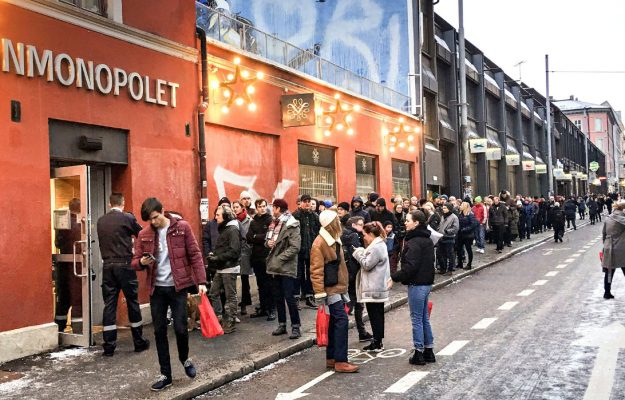A complex market, especially for the monopoly regime that dominates retail sales (while more space is available in Horeca), but profitable, because with a strong purchasing power, the Norwegian wine market, which, with Sweden, is a driving force in wine consumption, of the whole interesting area of Scandinavia, is particularly attractive to Italian producers, with the two countries that, in the first half of 2019, imported Italian wine for over 135 million euros (Istat and Wine Monitor data).
The Norwegian market in particular is increasingly attentive to quality, with consumers with a high spending capacity, who especially love the triad of Piedmont, Tuscany and Veneto, and are also increasingly inclined to experiment with new labels and types of wine from other regions and territories, with a shift in tastes, however, that in this phase rewards particularly sparkling and rosé wines, as happens almost everywhere in the world. Feelings that come from "Simply Italian Great Wines" by Iem (International Exhibition Management by Giancarlo Voglino and Marina Nedic), yesterday, in Oslo, Norway.
“Scandinavia confirms itself over time as a market with great potential, where the quality of products pays off - explains Marina Nedic - Norwegian wine lovers are evolved consumers with high purchasing power. And they ask for wines with greater added value, rewarding excellent Italian and French productions”. According to a study by Kantar TNS for Vinmonopolet, the Norwegian monopoly (which controls 80% of the spirits market, and also operates specialized retail stores), alongside a “cost-focused” consumer, price-conscious and oriented towards simple products (19%), the vast majority of buyers are wine lovers looking for advice on purchases and open to tasting new labels (38%) and connoisseurs of the world of wine, aware of their tastes (another 31%); and there is no shortage of expert drinkers, in search of new inspirations (12%). In the Scandinavian wine world, too, there is a progressive revolution in consumption, parallel to the boom in artisan beers. Per capita consumption is still around 14 liters of wine per year, but consumers are increasingly interested in fresher and less alcoholic types, such as rosé and sparkling wines: the trend is “less but better”. This trend is taking hold in urban and rural areas, as well as the spread of a healthier lifestyle, but also because of the consequences of climate change, which has led to longer and warmer summers even in these latitudes.
Imports of Italian wine reflect the trends highlighted. The driving success of Prosecco continues, especially among the latest generations of Scandinavian consumers, with a double-digit increase in value (11.33 million euros, +10.6%) and an average price of all respect (4.7 euros per liter), parallel to the demand for lighter labels, with residual sugar content. “The market for Italian PDO wines is still dominated by Piedmontese and Veneto red wines (13.5 and 12.58 million euros), but emerging types such as white wines from the north-east and Asti Spumante, which, although with absolute values still contained, see a growth of more than +38%. A promising niche is also represented by the lighter red wines produced in the northern regions: the performance of Trentino Alto Adige is good”, Marina Nedic concludes.
“The Norwegian market is very rich, the per capita income is three times higher than the Italian one - pointed out to WineNews Alberto Colella, Ambassador of Italy in Norway - and this means having a spending capacity three times greater than ours. They also spend a lot on alcohol and wine, obviously all imported from abroad, with Italy leading the red wine market, with a share of 30-35%, which drops to 20% for whites and becomes almost a “monopoly” on bubbles, with a share of 80%, while rose wines are still in their infancy. A respectable positioning, but here the quality of the price counts more: cheap wines do not have a large market, a Norwegian, who is passionate, does not care at the expense, the queue outside the shops of the monopoly on Friday afternoon is very common. The monopoly regime, however, is a critical one, since wine imports are almost totally dominated by the State, which imports wine according to tenders, linked to specific types of wines, essentially the most in demand on the market. It is a system that exists here as in all Scandinavian countries and it works: in the monopoly shops the variety of the offer is exceptional, in the smallest there are 400 different labels. A tip I give to Italian producers is to tell the story behind their wines, because the Norwegian consumer is curious, he wants to know what's behind it: the more you insist on the history and tradition behind a bottle, the more passionate the consumer will be. On young people, on the other hand, the question is broad. The bag-in-box is strong, and here, among young people, also thanks to its low cost, it is a huge success. It's a growing sector, and many Italian companies are riding the trend”. But there is also a problem of abuse, emphasizes the ambassador, which should not be underestimated.
In any case, Norway and the Scandinavian market in general, look with interest to Italian producers, both those already present and those who try to enter.
“The Scandinavian market is quite important for Italian wine -Federica Rossodivita, export manager for the Abruzzo-based brand Masciarelli, told WineNews- but there are important difficulties at the entrance, due to the monopoly. The most present Italian wines are undoubtedly those from Veneto, Piedmont and Tuscany, with Apulia growing rapidly, but I think there is also space for the other regions, especially since Italy still has a lot to express in Northern Europe. Masciarelli has an important past in Norway and Denmark, but I think we can do even more, especially in markets where we are absent. We are focusing on reds, the type that is most appreciated here, also for climatic reasons as well as for consumption habits. We want to push the Montepulciano d'Abruzzo, both among the most experienced wine lovers and among newcomers”.
“Norway is a very careful country, especially with regard to red wines from native varieties: like Siddùra - explains Armando Russo, export manager of the historic Sardinian winery - we have a certain advantage, because although it is a difficult market, it is exactly our target. There is a lot of competition, but we are confident. We are not the most accredited company for monopoly tenders, perhaps we lack the numbers, we made one, which showed us the great appreciation of the market for our whites, but here we would like to focus on the reds, trying to find partners first of all in the horeca, the first step to make the brand known. We want to create relationships with local importers that allow us to grow in their area of expertise”.
Copyright © 2000/2025
Contatti: info@winenews.it
Seguici anche su Twitter: @WineNewsIt
Seguici anche su Facebook: @winenewsit
Questo articolo è tratto dall'archivio di WineNews - Tutti i diritti riservati - Copyright © 2000/2025









































































































































































































